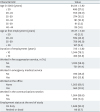1. World Bank. World development report 2012: gender equality and development. Washington, D.C.: World Bank;2011.
2. The Office of National Statistics. Changes in shift work patterns over the last ten years (1999 to 2009). London: Health and Safety Executive;2011.
4. Kumar S. Occupational exposure associated with reproductive dysfunction. J Occup Health. 2004; 46(1):1–19.


5. Kim KS. Health hazards in firefighters. Hanyang Med Rev. 2010; 30(4):296–304.

7. Evanoff BA, Rosenstock L. Reproductive hazards in the workplace: a case study of women firefighters. Am J Ind Med. 1986; 9(6):503–515.

9. Agnew J, McDiarmid MA, Lees PS, Duffy R. Reproductive hazards of fire fighting. I. Non-chemical hazards. Am J Ind Med. 1991; 19(4):433–445.


10. McDiarmid MA, Lees PS, Agnew J, Midzenski M, Duffy R. Reproductive hazards of fire fighting. II. Chemical hazards. Am J Ind Med. 1991; 19(4):447–472.


11. Bogucki S, Rabinowitz PM. Occupational health of police and firefighters. In : Rosenstock L, Cullen MR, Brodkin CA, Redlich CA, editors. Textbook of clinical occupational and environmental medicine. 2nd ed. Philadelphia: Elsevier Saunders, Inc.;2005. p. 272–278. DOI:
10.1016/B978-0-7216-8974-6.X5001-5.
12. Boffa JW, Stanley IH, Hom MA, Norr AM, Joiner TE, Schmidt NB. PTSD symptoms and suicidal thoughts and behaviors among firefighters. J Psychiatr Res. 2017; 84:277–283.


13. Bellieni CV, Buonocore G. Abortion and subsequent mental health: review of the literature. Psychiatry Clin Neurosci. 2013; 67(5):301–310.

14. van Beukering MD, van Melick MJ, Mol BW, Frings-Dresen MH, Hulshof CT. Physically demanding work and preterm delivery: a systematic review and meta-analysis. Int Arch Occup Environ Health. 2014; 87(8):809–834.


15. Feodor Nilsson S, Andersen PK, Strandberg-Larsen K, Nybo Andersen AM. Risk factors for miscarriage from a prevention perspective: a nationwide follow-up study. BJOG. 2014; 121(11):1375–1384.


19. Taeger D, Sun Y, Keil U, Straif K. A stand-alone windows applications for computing exact person-years, standardized mortality ratios and confidence intervals in epidemiological studies. Epidemiology. 2000; 11(5):607–608.

20. Mahoney MM. Shift work, jet lag, and female reproduction. Int J Endocrinol. 2010; 2010:813764.

23. Bonde JP, Jørgensen KT, Bonzini M, Palmer KT. Miscarriage and occupational activity: a systematic review and meta-analysis regarding shift work, working hours, lifting, standing, and physical workload. Scand J Work Environ Health. 2013; 39(4):325–334.


26. Kim DS, Moon MK, Kim KS. A survey of musculoskeletal symptoms & risk factors for the 119 Emergency Medical Services (EMS) activities. J Ergon Soc Korea. 2010; 29(2):211–216.
27. Kim MG, Seo JI, Kim K, Ahn YS. Nationwide firefighter survey: the prevalence of lower back pain and its related psychological factors among Korean firefighters. Int J Occup Saf Ergon. 2017; 23(4):447–456.


28. Figà-Talamanca I. Occupational risk factors and reproductive health of women. Occup Med (Lond). 2006; 56(8):521–531.

29. van Beukering MD, van Melick MJ, Mol BW, Frings-Dresen MH, Hulshof CT. Physically demanding work and preterm delivery: a systematic review and meta-analysis. Int Arch Occup Environ Health. 2014; 87(8):809–834.


30. Luke B, Papiernik E. The effects of lifestyle on prematurity. In : Elder MG, Lamont RF, Romer R, editors. Preterm labor. New York: Churchill Livingstone;1997. p. 127–152.
31. Ahn YS, Jeong KS, Kim KS.
MG Kim
. The analysis of risk factors related health and safety at disasters and development of special medical health examination system for firefighters. Seoul: Korea National Emergency Management Agency (NEMA);2011. p. 20–162. (Korean).
35. Ahn YS, Jeong KS, Kim KS. Cancer morbidity of professional emergency responders in Korea. Am J Ind Med. 2012; 55(9):768–778.


36. Barrett ES, Vitek W, Mbowe O, Thurston SW, Legro RS, Alvero R, et al. Allostatic load, a measure of chronic physiological stress, is associated with pregnancy outcomes, but not fertility, among women with unexplained infertility. Hum Reprod. 2018; 33(9):1757–1766.



37. Melius J. Occupational health for firefighters. Occup Med. 2001; 16(1):101–108.

39. Schlader ZJ, Chapman CL, Sarker S, Russo L, Rideout TC, Parker MD, et al. Firefighter work duration influences the extent of acute kidney injury. Med Sci Sports Exerc. 2017; 49(8):1745–1753.


41. Aronson KJ, Dodds LA, Marrett L, Wall C. Congenital anomalies among the offspring of fire fighters. Am J Ind Med. 1996; 30(1):83–86.

42. Hammer PE, Garde AH, Begtrup LM, Flachs EM, Hansen J, Hansen ÅM, et al. Night work and sick leave during pregnancy: a national register-based within-worker cohort study. Occup Environ Med. 2019; 76(3):163–168.










 PDF
PDF Citation
Citation Print
Print



 XML Download
XML Download